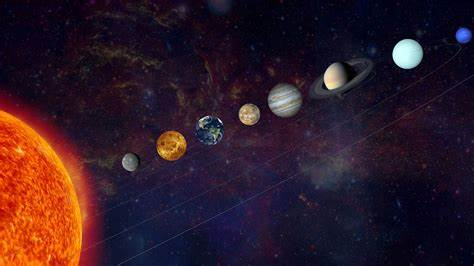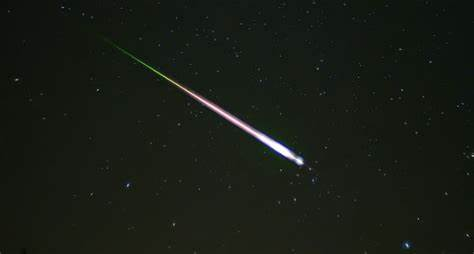The universe is constantly in motion, and the coming decades promise a series of celestial displays that will dazzle and awe. Whether you’re a seasoned astronomer or a casual stargazer, these phenomena provide a unique opportunity to witness the dynamics of our universe in real-time. Each event, ranging from rare planetary alignments to breathtaking meteor showers, offers a unique glimpse into the workings of celestial mechanics. As these events unfold over the next fifty years, they invite us to look up and connect with the wonders of the cosmos.
10. Planetary Alignment (2040)
In 2040, a rare planetary alignment will occur involving Mercury, Venus, Mars, Jupiter, and Saturn, visible alongside a crescent moon. Historically, these alignments have influenced cultures and been useful for calibrating astronomical instruments. The last notable alignment was in January 2024, involving Mars, Venus, and Mercury.
9. Super Blue Moon (2037)
A superblue moon combines a full moon, a supermoon, and a blue moon. The next super blue moon will occur in January and March of 2037. This rare event happens when the moon is at its closest point to Earth, making it appear larger and brighter.
8. Great Conjunction of Jupiter and Saturn (2040)
The next great conjunction of Jupiter and Saturn will occur in November 2040, where they will be separated by an angle approximately the size of two full moons. This event is a result of their orbital paths aligning and was last notably seen in December 2020.
7. The Leonid Meteor Shower Peak (2031)
The Leonid meteor shower, historically producing spectacular meteor storms, will peak around November 18, 2031. With up to 15 meteors per hour, this event will be best viewed from a dark location with minimal moonlight interference.
6. Perseid Meteor Shower Peak (August 2028)
In August 2028, the Perseid meteor shower is predicted to put on an exceptional display. Earth will intersect with dense dust filaments from Comet Swift-Tuttle, potentially creating a "meteor storm" with over 1,000 meteors per hour.
5. Full Moon on a Leap Day (2048)
A full moon on Leap Day, February 29, is an extremely rare event, occurring approximately once every 236 years. The next full moon on this date is expected in 2048, followed by occurrences in 2124 and 2268.
4. Total Solar Eclipse (August 12, 2045)
The "Greatest American Eclipse" on August 12, 2045, will offer a record totality duration of 6 minutes and 4 seconds. This eclipse will traverse 12 U.S. states and provide numerous accessible viewing locations.
3. Halley’s Comet Return (2061)
Halley’s Comet, the most famous comet, will return to Earth in 2061. This event will be an extraordinary spectacle, potentially much brighter than its last visit in 1986, and will favor observers in the Northern Hemisphere during late spring and early summer.
2. Saturn’s Rings Will “Disappear” (2025)
In 2025, Saturn’s rings will appear to "disappear" due to the planet’s shifting tilt as it orbits the Sun. This temporary alignment will render the rings nearly undetectable from Earth, providing a special opportunity to observe Saturn’s moons more distinctly.
1. Transit of Mercury (November 13, 2032)
The next Mercury transit, where the planet passes directly between Earth and the Sun, will occur on November 13, 2032. This rare event provides a unique opportunity to observe Mercury in motion against the backdrop of the Sun.
In August 2028, the Perseid meteor shower is predicted to put on an exceptional display. Earth will intersect with dense dust filaments from Comet Swift-Tuttle, potentially creating a "meteor storm" with over 1,000 meteors per hour.
5. Full Moon on a Leap Day (2048)
A full moon on Leap Day, February 29, is an extremely rare event, occurring approximately once every 236 years. The next full moon on this date is expected in 2048, followed by occurrences in 2124 and 2268.
4. Total Solar Eclipse (August 12, 2045)
The "Greatest American Eclipse" on August 12, 2045, will offer a record totality duration of 6 minutes and 4 seconds. This eclipse will traverse 12 U.S. states and provide numerous accessible viewing locations.
3. Halley’s Comet Return (2061)
Halley’s Comet, the most famous comet, will return to Earth in 2061. This event will be an extraordinary spectacle, potentially much brighter than its last visit in 1986, and will favor observers in the Northern Hemisphere during late spring and early summer.
2. Saturn’s Rings Will “Disappear” (2025)
In 2025, Saturn’s rings will appear to "disappear" due to the planet’s shifting tilt as it orbits the Sun. This temporary alignment will render the rings nearly undetectable from Earth, providing a special opportunity to observe Saturn’s moons more distinctly.
1. Transit of Mercury (November 13, 2032)
The next Mercury transit, where the planet passes directly between Earth and the Sun, will occur on November 13, 2032. This rare event provides a unique opportunity to observe Mercury in motion against the backdrop of the Sun.








0 Comments